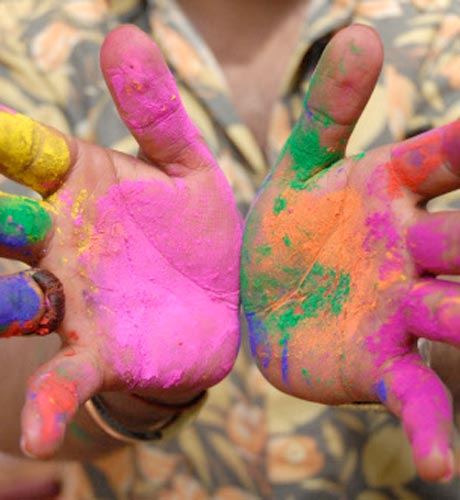Go Organic this Holi
By Ritu Verma | Mar 14, 2009

Experts say these colours can harm our skin, hair and can cause respiratory problems too.
Holi is synonymous with smiles, gaiety and colours. However, the chemicals used in coours can be a dampener on spirits.
Experts say these colours can harm our skin, hair and can cause respiratory problems too. Many people suffer from skin and eye allergies because of these chemicals.
Health hazards of Holi colours
Different kinds of chemicals, which can prove harmful, are used to produce Holi colours.
Green : The copper sulphate used can cause temporary blindness and eye allergies.
Silver : It may include aluminium bromide, a carcinogenic or agent involved in causing cancer.
Red : Your favourite gulal may contain mercury sulphite, which can cause skin cancer, mental retardation or paralysis.
Purple : It may contain chromium iodide that can lead to various allergies and asthma.
Staying indoors on this festival of cheer is not a great idea. Instead, doctors suggest playing Holi with organic colours. Many stores now offer these natural colours.
In fact, making these colours at home is also an easy, intelligent and fun option. So here a few tips to help you prepare for an ‘Organic Holi’.
Yellow: Say it with flowers!
Turmeric (haldi) and gram flour (besan) are an important part of our homemade face packs. You can mix both to create the colour yellow. You can substitute gram flour with talcum powder or fuller’s earth (multani mitti) too.
You can also dry flowers like marigold (gainda) or yellow chrysanthemums and crush them to a fine powder. Then, mix this powder with gram flour.
Red: Ek chutki sindoor!
Red seems to be everybody’s favorite colour on Holi. This year rather than smearing gulal on others, wish your friends with an amazing colour made of red sandalwood powder, which is very good for the skin too. Apart from that, you can use sindoor as well. Powder dry red hibiscus flowers and use them as gulal. You can also soak these flowers in water overnight to get wet colour.
Saffron: Ummm… smells good!
It’s said that Lord Krishna played Holi with tesu flowers, known as the Flame of the Forest (butea monosperma). You can either boil these flowers or soak them overnight to obtain a nice smelling orange colour.
You can also crush these dried tesu flowers to a powder, and then mix with sandalwood powder. It smells great and gives a very smooth touch.
Green: Beauty on duty!
You can use henna powder (mehndi), mixed with any suitable flour to attain a lovely green shade. Mehndi only leaves behind its colour when it’s wet and dry mehndi can be brushed off very easily. Those who love putting colour on people’s hair, do it with henna and save everyone a parlour visit too!
Leaves of gulmohur (delonix regia) can also be dried and powdered to attain a fine green colour.
Pink: The wet look!
For a wet pink, slice a few beetroots and soak them overnight in water or boil for a few minutes.
Black: Colour-cum-conditioner
You can boil gooseberries (fruits of amla) in an iron container for a few minutes and then keep it aside for a while. Dilute it with water and use. It also works as a conditioner!
Make a pact to go organic this Holi. You’ll be surprised at how much people welcome the colours and you. So, play Holi the natural way!
(With Inputs from Dr Monika Rajpal, consultant dermatologist, Apollo Hospital, Dr Anup Dhir, Cosmetologist and Dr Vandana Gupta consultant dermatologist)















